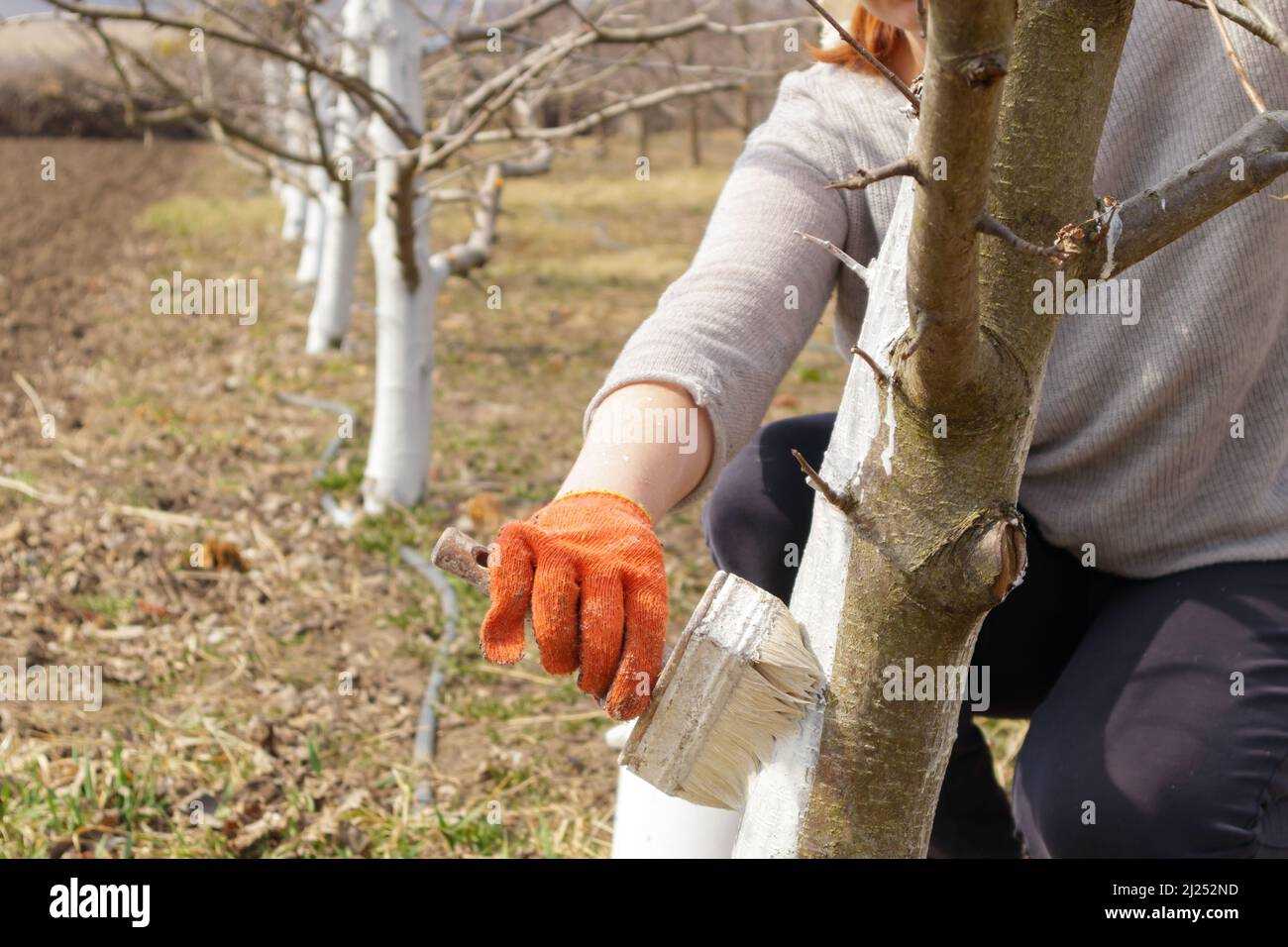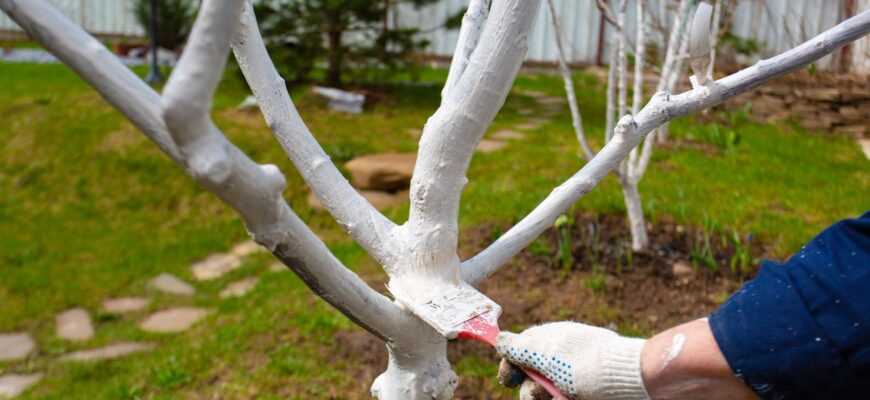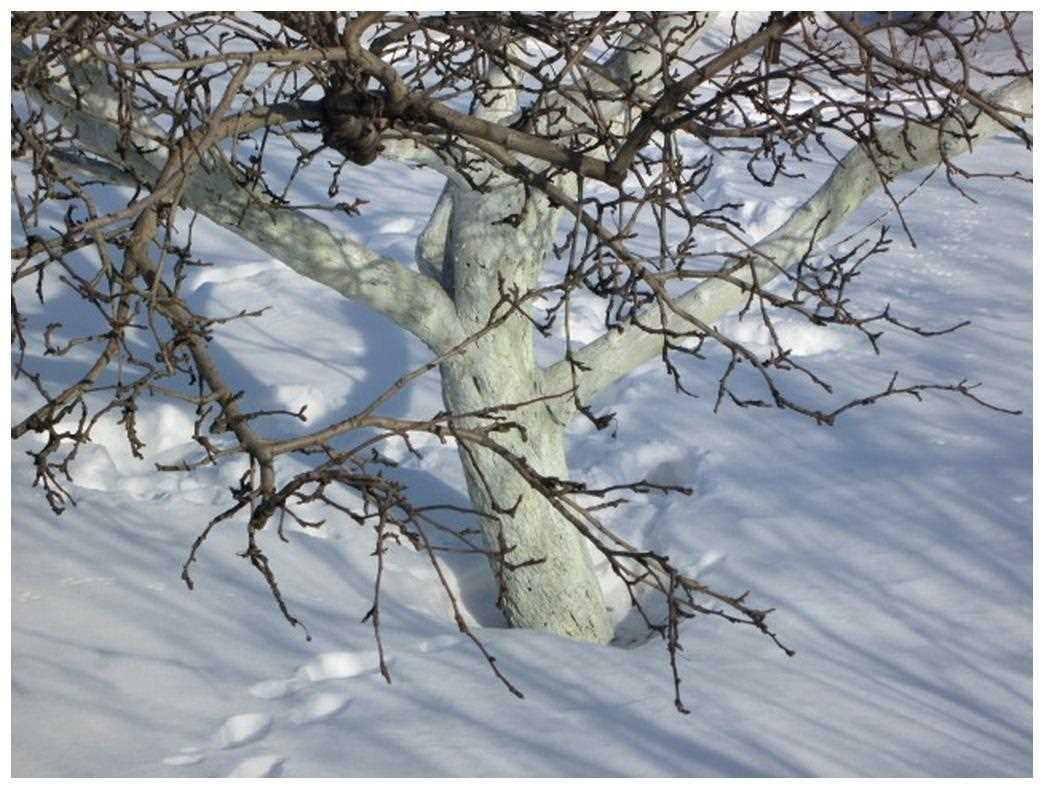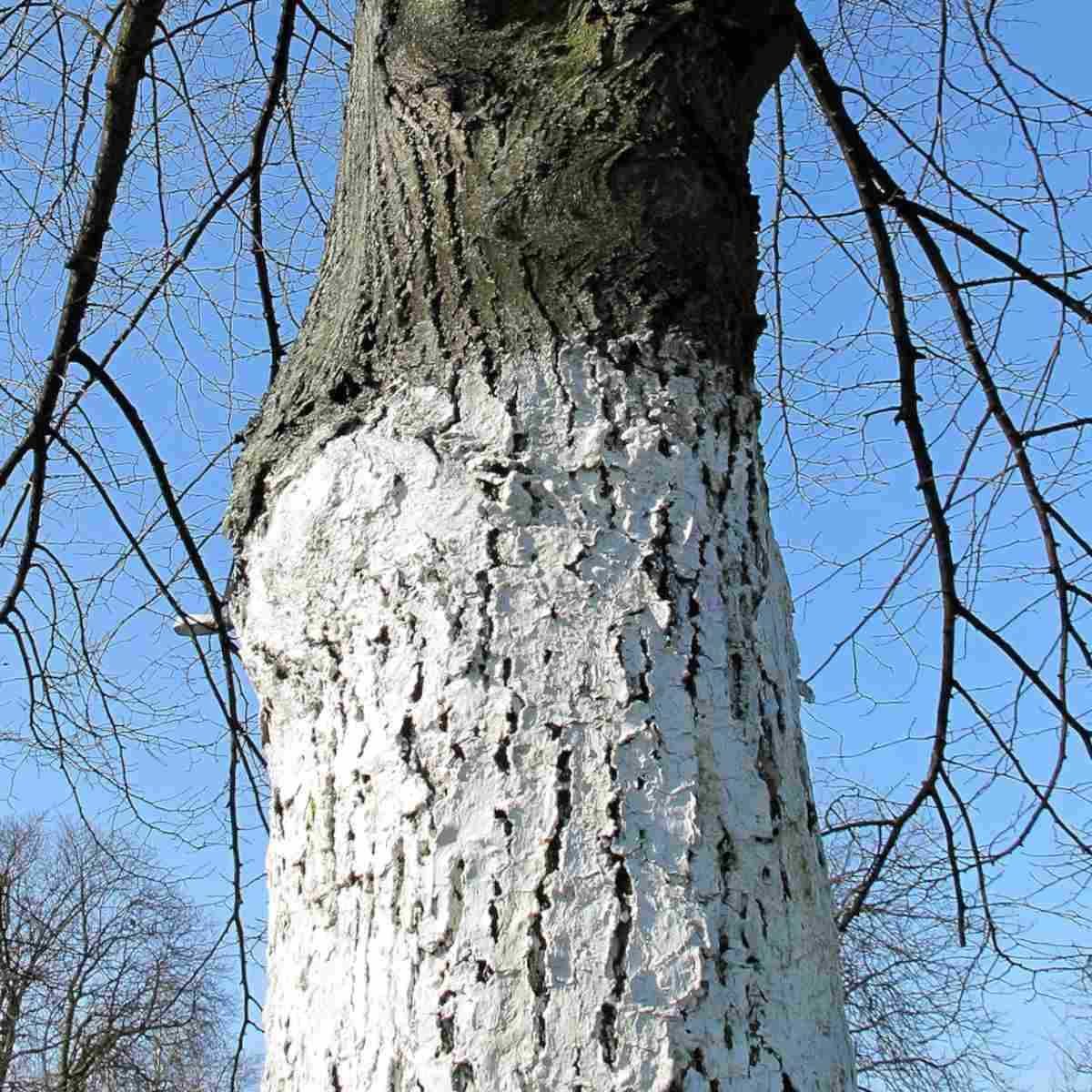- Benefits of Whitewashing Trees in Autumn and Spring
- Protection against sunburn
- Prevention of temperature fluctuations
- Prevention of pest infestation
- Enhancement of tree appearance
- Prevention of diseases and fungal infections
- Identification of tree damage
- Protection against Harsh Weather Conditions
- Prevention of Pest Infestation
- Benefits of Whitewashing for Pest Prevention:
- Promotion of Healthy Growth
- Preservation of Moisture
- Reduction of Sun Damage
- Enhancing Aesthetic Appeal
- Long-Term Cost Savings
- Environmental Sustainability
- Benefits of Whitewashing for Environmental Sustainability
- Considerations for Environmental Sustainability
- Conclusion
- Question-answer:
- Why is it important to whitewash trees in autumn and spring?
- When is the best time to whitewash trees?
- What materials are needed to whitewash trees?
- Can whitewashing trees prevent sunscald?
- How often should trees be whitewashed?
- Is whitewashing trees environmentally friendly?
- Can whitewashing trees improve fruit tree production?
- Video: YOUR TREES WILL BURN! | Avoid Tree Damage by White Washing / Collab with Charles @ IV Organics
When it comes to tree care, there are many techniques and practices that can help improve their health and longevity. One such technique that is often overlooked is whitewashing. Whitewashing trees involves applying a protective coating to their trunks and branches, which can provide a range of benefits.
Whitewashing can help protect trees from various environmental factors, such as harsh sunlight, extreme temperatures, and pests. The white coating acts as a barrier, reflecting sunlight and reducing the risk of sunburn and heat stress. It also helps prevent the bark from cracking and drying out during the colder months.
In addition to its protective properties, whitewashing can also help improve the overall appearance of trees. The white coating creates a clean and uniform look, enhancing the aesthetic appeal of any landscape. It can be especially beneficial in autumn and spring when trees go through seasonal changes and may appear dull or bare.
Furthermore, whitewashing provides an opportunity for early detection of tree diseases and infestations. By regularly inspecting the white coating, you can easily spot any signs of damage or distress. This allows for timely intervention and treatment, preventing further harm to the trees.
In conclusion, whitewashing trees in autumn and spring is a simple yet effective way to protect and enhance their health. Whether you’re a homeowner or a professional arborist, considering this technique can bring numerous benefits and contribute to the overall well-being of your trees.
Benefits of Whitewashing Trees in Autumn and Spring
Whitewashing trees during the autumn and spring seasons can provide various benefits to the overall health and well-being of the trees. Here are some reasons why you should consider whitewashing your trees:
Protection against sunburn
Whitewashing acts as a protective shield against the harmful effects of direct sunlight. The white color reflects the sunlight, preventing the tree bark from absorbing excessive heat. This helps to reduce the risk of sunburn, especially for young and sensitive trees.
Prevention of temperature fluctuations

Whitewash helps to regulate the temperature of tree trunks by preventing extreme temperature fluctuations. It acts as an insulator, keeping the tree cooler in hot weather and warmer in colder weather. This stability in temperature can promote healthier growth and development of the tree.
Prevention of pest infestation
Whitewashing trees can act as a deterrent to certain pests and insects. The white color makes it difficult for pests to spot and locate the tree, reducing the chances of infestation. Additionally, some whitewash mixtures can contain insect-repellent properties, further deterring pests from attacking the tree.
Enhancement of tree appearance

Whitewashing can improve the overall appearance of trees by giving them a fresh and clean look. It can help to brighten up the landscape, making the trees stand out in a visually appealing way. This can be especially beneficial in urban environments where trees often provide aesthetic value.
Prevention of diseases and fungal infections
Whitewash can act as a barrier against certain diseases and fungal infections that affect tree bark. The thick coating of whitewash can help prevent the entry and spread of pathogens, protecting the tree from potential harm. Regular whitewashing can help maintain the health of the tree and prevent the onset of various diseases.
Identification of tree damage
By regularly whitewashing trees, it becomes easier to identify any signs of damage or disease. The white coating can highlight any irregularities on the tree bark, making it easier to spot potential issues and take appropriate action. This early detection can help prevent further damage and promote timely tree care.
In conclusion, whitewashing trees in autumn and spring can provide several benefits, including protection against sunburn, prevention of temperature fluctuations, deterrence of pests, enhancement of appearance, prevention of diseases, and easy identification of tree damage. Consider whitewashing your trees as part of your tree care routine for healthier and more beautiful trees.
Protection against Harsh Weather Conditions
Whitewashing trees in autumn and spring can provide protection against harsh weather conditions. The whitewash acts as a barrier, shielding the tree’s bark from extreme temperatures, intense sunlight, and strong winds.
During winter, when temperatures drop significantly, trees can suffer from frost damage. The whitewash reflects sunlight and helps to prevent the rapid temperature fluctuations that can often cause frost cracks in the bark.
In the summer months, the whitewash can protect the tree from the scorching heat and sunburn. The reflective properties of the whitewash reduce the absorption of sunlight, keeping the tree’s surface cooler and preventing sun-related stress and damage.
Additionally, whitewashing can also protect trees from strong winds. The thick coat of whitewash acts as a windbreak, reducing the force of the wind on the tree’s branches and trunk. This can help prevent branch breakage and minimize the risk of the tree being uprooted.
Overall, whitewashing trees in autumn and spring provides a proactive measure to safeguard them against the harsh weather conditions they may face throughout the year.
Prevention of Pest Infestation

One of the main reasons to consider whitewashing trees in autumn and spring is for the prevention of pest infestation. Pests like beetles, aphids, and caterpillars can cause significant damage to trees, both in terms of their appearance and their overall health.
By applying a whitewash solution to the trunks and branches of trees, you create a physical barrier that can deter pests from climbing up and infesting the tree. The white color of the whitewash also acts as a repellent, as many pests are naturally attracted to darker colors.
Furthermore, whitewashing can help to prevent the spread of certain diseases that are transmitted by insects. Some pests can carry diseases from one tree to another, and by creating a barrier with whitewash, you reduce the risk of infection and infestation.
In addition to acting as a deterrent, whitewash also has antifungal properties. Many fungal diseases can affect trees, especially during periods of high humidity or excessive moisture. Whitewashing the trees can help protect them from fungal growth and reduce the risk of diseases like powdery mildew or canker.
Regularly applying whitewash to trees can also help homeowners and gardeners monitor the health of their trees more easily. By inspecting the whitewash coating for any signs of pests or diseases, you can take timely action to address potential issues and prevent further damage.
It’s important to note that whitewashing alone is not a foolproof method of preventing pest infestation or disease, but it can be a valuable part of an overall tree care and maintenance plan. Proper pruning, regular inspections, and appropriate watering and fertilization are also necessary to ensure the long-term health and vitality of trees.
Benefits of Whitewashing for Pest Prevention:
- Deters pests from climbing up trees
- Repels pests attracted to darker colors
- Prevents the spread of diseases carried by insects
- Antifungal properties help protect against fungal diseases
- Allows for easier monitoring of tree health
Promotion of Healthy Growth
Whitewashing trees in autumn and spring can promote healthy growth in several ways:
- Protection against pests and diseases: Whitewashing creates a physical barrier on the tree’s bark, making it more difficult for pests and diseases to infest the tree. The white color also reflects sunlight, which can help keep the tree cooler and discourage the growth of harmful organisms.
- Prevention of sunscald: Sunscald occurs when the temperature fluctuates rapidly, causing the bark to expand and contract. This can result in cracks and damage to the tree. Whitewashing helps to regulate the temperature of the tree’s bark by reflecting sunlight and reducing the risk of sunscald.
- Protection against frost: During periods of frost, whitewashing can provide some insulation to the tree’s bark. The white color reflects sunlight, helping to keep the tree’s tissues from freezing. This can prevent damage to the tree and promote healthy growth.
- Moisture regulation: Whitewashing can help regulate the moisture levels in the tree’s bark. It creates a protective layer that reduces water loss through evaporation. This is particularly beneficial in dry and windy climates, where trees may struggle to retain moisture.
- Reduction of temperature stress: Trees exposed to high temperatures can experience stress, which can affect their overall health and growth. Whitewashing can help reduce temperature stress by reflecting sunlight and keeping the tree’s bark cooler. This can promote healthy growth and increase the tree’s resilience to heat.
Overall, whitewashing trees in autumn and spring can provide significant benefits for their health and growth. It protects against pests, diseases, sunscald, frost, and temperature stress, while regulating moisture levels in the bark. By promoting healthy growth, whitewashing can contribute to the longevity and vitality of trees.
Preservation of Moisture
One of the primary reasons to consider whitewashing trees in autumn and spring is to preserve moisture in the bark and wood. By applying a protective whitewash coating, you can create a barrier that helps retain moisture and prevent dehydration of the tree.
During the dry seasons, trees can lose significant amounts of moisture through their bark. This loss of moisture can lead to dehydration, which can weaken the tree and make it more susceptible to diseases and pests. By whitewashing trees, you can help reduce this moisture loss, keeping the tree healthier and more resilient.
Whitewashing can also help regulate the temperature of the tree trunk. By reflecting sunlight, the white coating prevents excessive heating of the bark, which can cause expansion and contraction. These temperature fluctuations can lead to cracks in the bark, creating openings for pathogens and pests to enter.
Furthermore, whitewashing can protect the tree from frost damage. During cold weather, the whitewash acts as an insulating layer, buffering the tree against extreme temperatures. This insulation helps prevent freezing and the subsequent damage that can occur to the inner layers of the tree.
In addition to these moisture-preserving benefits, whitewashing also provides a visual deterrent to pests, such as insects and rodents. The bright white color can confuse and deter these pests, reducing the risk of infestation and damage to the tree.
To maximize the moisture-preserving effects of whitewashing, it is important to apply the coating properly. Whitewash should be applied evenly and thoroughly, covering the entire trunk and branches. It is recommended to use a paintbrush or sprayer for larger trees for better coverage. The whitewash should be reapplied as needed, typically every year or two, to ensure continued protection.
Reduction of Sun Damage
Whitewashing trees in autumn and spring can help reduce sun damage to the bark and branches. The intense rays of the sun, especially during the summer months, can cause harm to the delicate tissues of trees.
By applying a layer of whitewash, the sunlight is reflected away from the tree, reducing the amount of heat absorbed and protecting the tree from excessive drying out. This can be particularly important for young or newly planted trees that have not yet developed a thick protective bark.
Furthermore, whitewashing can prevent sunscald, which occurs when the bark heats up during the day and then rapidly cools down at night. This drastic change in temperature can cause the bark to crack, leading to long-term damage and potential susceptibility to pests and diseases.
Whitewashing also provides a protective barrier against harmful UV rays. Just as sunscreen protects our skin from sunburn, whitewash shields the tree’s bark from UV radiation, which can cause cell damage and premature aging. This is especially beneficial in regions with intense sunlight or areas experiencing heatwaves.
Additionally, whitewashing can help deter certain pests that are attracted to the color of the tree’s bark. Insects such as borers and bark beetles are known to target trees with dark or rough bark. By applying a white coating, the tree becomes less appealing to these pests, reducing the risk of infestation and subsequent damage.
In summary, whitewashing trees in autumn and spring helps to reduce sun damage by reflecting sunlight, protecting against sunscald, shielding against UV radiation, and deterring certain pests. It is a simple and cost-effective method to care for trees and promote their overall health and longevity.
Enhancing Aesthetic Appeal
Whitewashing trees in autumn and spring can significantly enhance the aesthetic appeal of your landscape. By applying a thin layer of white paint to the trunks and branches, you can create a striking visual contrast against the colorful foliage or the bare winter landscape.
The bright white color stands out against the natural backdrop, creating a focal point and adding visual interest to your outdoor space. Whether you have a small garden, a backyard, or a large estate, whitewashing trees can help create a more visually appealing environment.
In addition to the visual appeal, whitewashing trees can also make your property look more well-maintained and cared for. It gives the impression that you take pride in the appearance of your landscape and are committed to its upkeep.
Furthermore, whitewashing trees can help create a sense of unity and harmony in your garden or park. When multiple trees are whitewashed, they create a cohesive and coordinated look that can tie the entire space together.
Whether you choose to whitewash all your trees or just a select few, it can have a transformative effect on the overall aesthetics of your outdoor space. The clean, white appearance of the trees can create a fresh and inviting atmosphere, making your garden or park a more enjoyable place to relax and spend time in.
Long-Term Cost Savings

One of the major benefits of whitewashing trees in autumn and spring is the potential for long-term cost savings. While initially, it may seem like an unnecessary expense, whitewashing can actually help save money in the long run.
Here are a few ways in which whitewashing trees can lead to cost savings:
- Reduced risk of sunscald: Whitewashing serves as a protective barrier against harsh sunlight, which can cause sunscald. Sunscald occurs when the winter sun heats up the tree bark during the day, only for the temperature to drop dramatically at night. This drastic temperature change can lead to cracks in the bark and damage to the tree. By whitewashing the tree, you can minimize the risk of sunscald and avoid costly repair or removal of damaged trees.
- Prevention of insect infestation: Certain insects are attracted to the color and texture of tree bark, especially when it is young and vulnerable. By whitewashing the trees, you create a less appealing surface for insects to land on and lay their eggs. This can help prevent infestations and reduce the need for expensive pest control treatments.
- Protection against diseases: Whitewashing can also act as a barrier against various tree diseases. Some fungal infections, such as apple and pear scab, can be prevented or minimized by applying a protective layer of whitewash. By protecting the trees from diseases, you can avoid the need for costly fungicides or other treatments.
By investing in whitewashing your trees, you are taking proactive measures to protect their health and longevity. This can save you money in the long run by avoiding costly repairs, removals, and treatments that may be necessary if your trees suffer from sunscald, insect infestations, or diseases.
Environmental Sustainability
When considering whitewashing trees in autumn and spring, it is important to also think about the impact on environmental sustainability. Whitewashing can have both positive and negative effects on the environment, depending on how it is done and the specific context in which it is applied.
Benefits of Whitewashing for Environmental Sustainability
- Protection against sunburn: Whitewashing trees can help protect them from sunburn, especially during hot summer months. This can prevent damage to the bark and underlying tissues, promoting the tree’s overall health and longevity.
- Reduced water loss: By creating a protective barrier on the tree’s surface, whitewashing can help reduce water loss through evaporation. This can be especially beneficial for trees in arid or drought-prone regions, where water conservation is crucial.
- Reduced pest infestation: The white color of the whitewash can deter certain pests, such as aphids, which are attracted to the darker shades of tree bark. This reduces the likelihood of pest infestations and the need for chemical pesticides that can harm both the environment and beneficial insects.
Considerations for Environmental Sustainability
While whitewashing trees can offer environmental benefits, it is important to consider the potential negative aspects as well:
- Chemical content: Some commercial whitewash products may contain harmful chemicals or volatile organic compounds (VOCs). It is important to choose environmentally-friendly and non-toxic options that minimize harm to the ecosystem.
- Application technique: Applying whitewash in a thick and uneven manner can interfere with the tree’s natural processes, such as gas exchange through the bark. This can negatively impact the tree’s health and overall sustainability.
- Impact on biodiversity: Trees play a critical role in supporting biodiversity by providing habitats for various species. Whitewashing trees may alter the natural appearance of tree bark and camouflage, making it more difficult for wildlife to find suitable nesting and feeding spots.
Conclusion
When considering whitewashing trees in autumn and spring, it is essential to evaluate the environmental impacts and take steps to promote sustainability. This can be achieved by using eco-friendly whitewash products, applying them carefully and sparingly to minimize interference with the tree’s natural processes, and considering the potential impacts on biodiversity. By doing so, we can protect and enhance the health of our trees while also being mindful of our ecological responsibilities.
Question-answer:
Why is it important to whitewash trees in autumn and spring?
Whitewashing trees in autumn and spring is important for several reasons. First, it helps protect the tree’s bark from extreme temperature changes. Second, it acts as a barrier against insects, fungi, and diseases. Lastly, it helps to brighten up the tree’s appearance and improve its aesthetic appeal.
When is the best time to whitewash trees?
The best time to whitewash trees is in autumn and spring. In autumn, it helps protect the tree from the harsh winter conditions, while in spring, it provides a barrier against pests and diseases. It is important to apply the whitewash when the tree is dormant and the weather is dry.
What materials are needed to whitewash trees?
To whitewash trees, you will need whitewash paint, a paintbrush or sprayer, water, and a bucket. You can either purchase ready-made whitewash paint or make your own by mixing water and lime-based paint. It is important to ensure the paint is safe for plants.
Can whitewashing trees prevent sunscald?
Yes, whitewashing trees can help prevent sunscald. Sunscald occurs when the bark is exposed to excessive sunlight, causing it to become damaged and crack. Whitewash provides a reflective surface that helps to reduce the amount of sunlight the bark absorbs, thus preventing sunscald.
How often should trees be whitewashed?
The frequency of whitewashing trees depends on various factors such as weather conditions, tree species, and the quality of the whitewash. As a general guideline, trees should be whitewashed every 1-3 years. However, it is important to regularly inspect the whitewash and reapply as needed to maintain its effectiveness.
Is whitewashing trees environmentally friendly?
Whitewashing trees can be considered environmentally friendly when using non-toxic, plant-safe paints. It provides a natural protective barrier for trees without causing harm to the environment. It is essential to choose whitewash paints that are free from harmful chemicals and safe for plants.
Can whitewashing trees improve fruit tree production?
Yes, whitewashing trees can improve fruit tree production. By protecting the bark from extreme temperature changes, whitewashing helps to maintain stable conditions for the tree, which can have a positive impact on fruit production. It also helps deter pests and diseases that can harm the fruit trees.







